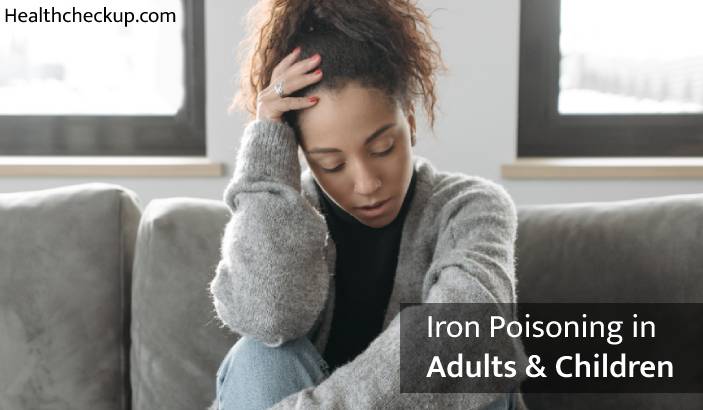Iron poisoning is a common condition due to the presence of iron in several vitamin and mineral supplements available over-the-counter. Children are at increased risk for iron poisoning. Iron poisoning in children may have more severe life-threatening complications than iron poisoning in adults.
Iron Poisoning Symptoms
Patients with iron poisoning may have several symptoms. The signs of iron poisoning are:
- Abdominal pain
- Nausea
- Vomiting blood
- Black and bloody stools
- Headache
- Fever
- Seizure
- Shortness of breath
- Bluish or greying colour of the skin
- Dizziness
- Low blood pressure
Iron Poisoning Causes
There are several causes of iron poisoning. Some of them are:
-
Iron overload:
The patients may have iron poisoning due to chronic iron toxicity. The patients may have iron poisoning from supplements. It may be due to excessive iron therapy through intravenous formulations, repeated transfusion of blood to treat medical conditions, such as anaemia, and the presence of underlying medical conditions, such as alcoholism or chronic hepatitis.
-
Iron overdose:
Majority of the iron poisoning occurs due to the ingestion of too much iron supplement by an adult or children. Between 1983 to 2000, 43 children in the US died from ingesting iron in a dose over 35 mg/kg body weight. The availability of chewable iron tablets and gummies has further increased the risk of iron poisoning. Accidental overdose of iron may cause acute iron toxicity, and the risk is highest in children below the age of 5 years.
-
Underlying genetic conditions:
Some genetic conditions also result in iron poisoning. A condition known as hemochromatosis may cause iron poisoning. In this condition, the body absorbs abnormal levels of iron from food.
Iron Poisoning Pathophysiology
The ingestion of excessive iron may cause tissue damage in the gastrointestinal tract. It may result in abdominal pain, nausea, vomiting, and diarrhoea. The patients may have excessive fluid and blood loss leading to hypovolemia. The patient may also experience haemorrhagic necrosis resulting in peritonitis and perforation. Cellular metabolism impairment may also occur due to iron toxicity, affecting vital organs, such as the heart, nervous system, and liver. The iron enters the cell and accumulates in the mitochondria. It interferes with oxidative phosphorylation, generates free radicals and causes cell death. Metabolic acidosis may also occur in iron toxicity.
Complications of Iron Poisoning
Untreated and prolonged iron poisoning may result in the following complications:
- Liver failure may occur, and the patients may also experience problems with blood clotting and may have excessive bleeding.
- Major digestive issues may occur due to extensive damage to the gastrointestinal system.
- Cirrhosis, a condition characterised by permanent scarring or life, may also occur due to iron poisoning.
- Death may occur primarily due to circulatory shock or liver failure.
Iron Poisoning Stages
There are the following stages of iron poisoning:
Stage I:The first stage lasts from 0.5 hours to 6 hours of ingestion. The patients experience symptoms related to the gastrointestinal tract, such as diarrhoea, abdominal pain, vomiting, and hematemesis.
Stage II: This stage may develop within 6 to 24 hours of ingestion. During this stage, there is a transient recovery phase from GI symptoms. However, there is the absorption of the toxic amount in the body.
Stage III: This stage may arrive within 6 to 72 hours after ingestion. The patients again experience GI symptoms, metabolic acidosis, and shock. This stage may also be characterised by cardiomyopathy, hepatic dysfunction, renal failure, and iron-induced coagulopathy.
Stage IV: At this stage, the patients may develop liver failure.
Stage V: This stage is characterised by the complications that may occur due to the healing of the gastrointestinal system. It may result in bowel obstruction and scarring.
Iron Poisoning Diagnosis
The doctor may diagnose the iron poisoning based on the following methods:
Physical evaluation:
The doctor evaluates the patients for iron toxicity based on the symptoms, medical history, and the types of drug the patient was taking. If the iron overdose is suspected, the doctor may advise further tests.
Blood tests:
The doctor may recommend blood tests to determine the level of iron in the blood. However, it is to be noted that iron rapidly disappears from the blood and accumulates in the liver. Thus, the iron level may be less than expected if the blood sample is taken after achieving the peak iron level in blood.
X-ray:
In some cases, the radiopaque iron tablets may also be seen in the X-ray. However, there is no association of poisoning severity with radiopacities.
Other tests:
Once the iron poisoning is confirmed, the doctor may also advise other tests to determine the health status of vital organs. The doctor may recommend the patient undergo liver tests, kidney tests, electrolyte levels, coagulation studies, and serum glucose levels.
Iron Poisoning Treatment
There are several treatment options for iron toxicity depending upon the severity. These are:
- For managing hypoperfusion and hypovolemia, IV crystalloid infusion may be administered.
- Patients with systemic toxicity, worsening symptoms, and metabolic acidosis may be administered deferoxamine, removing iron from the tissues.
- Fresh frozen plasma and vitamin K is administered to manage coagulopathy.
- Whole bowel irrigation may help remove the iron from the intestine before absorption.

Rohit Jain is an IPR Specialist and Medical Content Writing Expert. For over a decade, he has written several articles in the areas of female infertility, Erectile dysfunction, hemangioma, cervical cancer, monoclonal gammopathy of undetermined significance, mononucleosis, mitral valve disorder, nerve sheath tumor, shin splints, mild cognitive impairment, cellulitis, brain metastases, atelectasis, MCAD deficiency, lymphoma, sepsis, cardiac rehabilitation and metabolic disorder among others.








